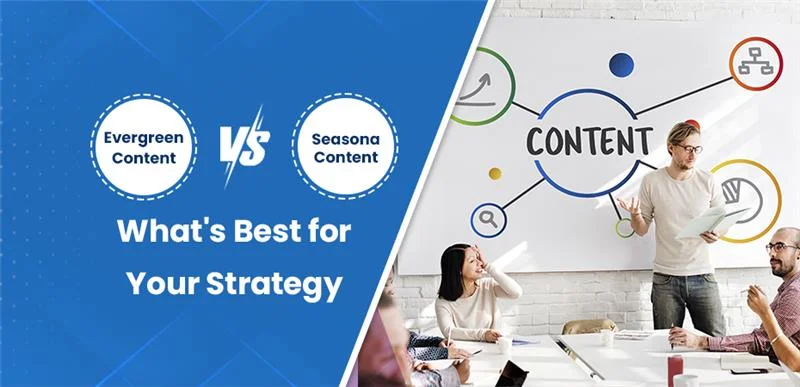Evergreen Content vs Seasonal: What’s Best for Your Strategy



Introduction
Content marketing success relies on two different approaches: evergreen vs seasonal content. Evergreen content remains fresh and relevant throughout the year, like a guide on “How to Start a Business in New York.” On the other hand, seasonal content focuses on time-sensitive opportunities, such as “Best Holiday Shopping Deals in Manhattan.”
A strong digital marketing strategy requires both types of content to maximize impact. Think of evergreen content as your steady foundation, consistently attracting traffic, while seasonal content generates excitement during specific periods.
In this guide, you’ll discover:
- The unique benefits of evergreen and seasonal content
- How to create effective content for both approaches
- Tips for selecting the right strategy for your business
- Ways to balance both content types in your marketing mix
- Strategies to adapt your content for Google’s latest updates
Understanding these elements will help you develop a robust content strategy that drives consistent traffic and captures seasonal opportunities for your New York business.
Evergreen Content Meaning and Definition
Evergreen content is a crucial part of digital marketing strategies in New York’s competitive business scene. Evergreen meaning in business and content, is a type of content stays relevant and valuable no matter the time, season, or current trends – just like evergreen trees that stay green all year round.
Advantages of Using Evergreen Campaigns in Your Strategy
1. Sustained Traffic Generation
- Consistent search volume throughout the year
- Steady flow of organic visitors
- Reliable source of leads and conversions
- Higher ROI due to extended content lifespan
2. Time-Tested Performance
A well-crafted piece of evergreen ads or content can generate traffic for years. Evergreen example of content includes, a comprehensive guide about “Starting a Business in New York” remains valuable to entrepreneurs regardless of when they discover it. Learn more about creating effective content distribution plans to maximize your evergreen content’s reach.
3. Resource Efficiency
- Minimal updates required
- Lower maintenance costs
- Reduced content creation frequency
- Better allocation of marketing budgets
4. Audience Trust Building
Evergreen marketing campaign helps establish your brand as an industry authority. When New York businesses consistently deliver valuable, timeless information, they create lasting relationships with their audience. This trust translates into:
- Higher engagement rates
- Increased brand loyalty
- Better conversion potential
- Enhanced reputation management
5. SEO Benefits
- Accumulates evergreen links over time
- Builds domain authority
- Improves search engine rankings
- Creates opportunities for internal linking
Ever-green marketing campaigns are the backbone of a strong content strategy. While seasonal trends come and go, evergreen content keeps providing value, making it a must-have investment for businesses aiming for long-term success online.
Crafting Effective Evergreen Content
Creating timeless content requires a strategic approach focused on delivering lasting value with evergreen topics. Here’s how to craft content that stands the test of time:
1. Focus on Core Topics
- Address fundamental problems in your industry
- Write about basic concepts that remain constant
- Target common questions your audience consistently asks
2. Structure for Clarity
- Break complex topics into digestible sections
- Use clear, simple language
- Include practical examples and actionable steps
3. SEO Optimization Tips
- Research and target stable, high-volume evergreen keywords
- Create comprehensive resource pages
- Build internal links to related evergreen content
- Update content periodically to maintain freshness
AI-generated content can help scale your evergreen advertising strategy, but human expertise remains crucial for creating truly valuable resources that resonate with New York businesses seeking long-term growth.
Understanding Seasonal Content
Seasonal content taps into specific times, events, or trends throughout the year. This dynamic content type creates excitement and drives engagement through time-sensitive opportunities. New York businesses can leverage seasonal campaigns to connect with their audience during key moments, from holiday shopping seasons to local events like NYC Restaurant Week.
Advantages of Implementing Seasonal Campaigns in Your Strategy
1. Creating Buzz and Urgency
- Time-limited offers spark FOMO (Fear Of Missing Out)
- Special seasonal promotions drive immediate action
- Scarcity marketing tactics boost customer response rates
2. Enhanced Brand Relevance
- Shows your brand stays current with trends
- Demonstrates cultural awareness
- Builds stronger connections with local communities
- Positions your business as responsive to customer needs
3. Peak Season Conversion Opportunities
- Higher purchase intent during seasonal events
- Increased customer spending during holidays
- Better ROI on marketing investments
- Targeted promotional opportunities
Seasonal marketing campaigns allows businesses to ride the wave of existing consumer behavior patterns. During the holiday season, New York retailers can create targeted campaigns that align with shoppers’ heightened buying intent. Similarly, restaurants can capitalize on summer dining trends with special outdoor seating promotions.
Creating effective shoppable content becomes particularly powerful during seasonal peaks. Businesses can integrate direct purchase options into their seasonal content, making it easier for customers to act on their immediate interest.
The key to successful seasonal campaigns lies in understanding your market’s specific timing. NYC businesses must consider:
- Local event calendars
- Weather patterns
- Cultural celebrations
- Industry-specific peaks
- Competitor promotional schedules
By aligning content with these factors, businesses can maximize their seasonal campaign impact and drive stronger results during peak periods.
Crafting Effective Seasonal Content
Creating impactful seasonal content requires precise timing and strategic planning. A successful seasonal campaign starts with research and preparation at least 2-3 months before the event.
Key elements for crafting seasonal content:
- Track social media trends and hashtags related to upcoming events
- Research past seasonal campaigns’ performance data
- Create content calendars aligned with local New York events
- Design visually appealing assets that reflect the season’s mood
- Develop a content distribution plan for maximum reach
Timing your seasonal content launch is crucial. Release content early enough to build anticipation but not so early that it loses relevance. For example, holiday marketing campaigns in New York typically start mid-October, while back-to-school campaigns begin in July.
Remember to incorporate FOMO elements by:
- Setting time-limited offers
- Using countdown timers
- Creating exclusive seasonal products
- Highlighting limited availability
Implementing scarcity marketing techniques can significantly boost engagement during seasonal campaigns.
Evergreen Content VS Seasonal Content
Evergreen and seasonal content serve distinct purposes in your marketing strategy. Let’s explore their key differences to help you make informed decisions for your New York business.
1. Duration and Shelf Life
- Evergreen SEO Content: Maintains relevance for years with minimal updates
- Seasonal Content: Peaks during specific timeframes, then becomes dormant
2. Content Focus
- Evergreen Content: Addresses fundamental questions, basic concepts, and timeless topics
- Seasonal Content: Targets trending topics, current events, and time-sensitive themes
3. Audience Engagement Patterns
Evergreen Content:
- Steady, consistent traffic flow
- Gradual increase in engagement over time
- Regular sharing across platforms
Seasonal Content:
- Sharp spikes in engagement during peak periods
- High initial interest followed by rapid decline
- Intense but short-lived social sharing
4. Resource Investment
Evergreen Content:
- Higher upfront investment
- Lower maintenance costs
- Continuous ROI potential
Seasonal Content:
- Quick production timeline
- Regular updates needed
- Time-sensitive ROI window
As highlighted in our comprehensive guide on content distribution plans, understanding these differences helps create a balanced content strategy. The key lies in recognizing how each type fits your business goals and audience needs.
5. Performance Metrics
- Evergreen Content: Measured through long-term page views, consistent rankings
- Seasonal Content: Evaluated by peak performance, immediate conversion rates
These distinct characteristics shape how each content type functions within your marketing ecosystem, influencing everything from creation to distribution strategies.
How to Choose Between Evergreen and Seasonal Content Strategies?
Selecting the right content mix requires careful consideration of your business objectives and audience behavior. Let’s explore key factors to guide your decision-making process.
Business Goals Assessment:
- Brand awareness goals need evergreen marketing content for consistent visibility
- Sales targets benefit from seasonal campaigns during peak shopping periods
- Lead generation works well with both types, depending on your industry
Target Audience Analysis:
- Review your audience’s search patterns
- Track engagement metrics across different seasons
- Monitor competitor content strategies in your New York market
Creating an effective content distribution plan helps maximize the impact of both content types.
Balancing Both Types in Your Marketing Strategy
A balanced content approach typically follows these ratios:
- 60% evergreen digital marketing content for steady traffic
- 30% seasonal content for timely engagement
- 10% experimental content for testing new approaches
Performance Metrics to Track:
- Page views and time on page
- Social shares and engagement rates
- Conversion rates during different periods
- ROI comparison between content types
AI-generated content tools can help create both evergreen and seasonal content efficiently.
Data-Driven Adjustments:
- Use Google Analytics to identify top-performing content
- Track seasonal peaks in your industry
- Measure content lifecycle and refresh schedules
- Analyze user behavior patterns
The ideal mix varies by industry. E-commerce businesses might lean toward seasonal content during holidays, while B2B companies often benefit from more evergreen content. Shoppable content strategies work well for both approaches, especially in the competitive New York market.
Regular performance reviews help refine your content ratio. Start with a 50/50 split and adjust based on your specific metrics and audience response. This flexible approach allows for strategic shifts as market conditions change.
Conclusion
Your content strategy success depends on finding the right mix of evergreen and seasonal content for your unique business needs.
The key is not choosing one over the other, but understanding how to use both effectively. Start by analyzing your business goals, target audience, and industry trends. SEO Expert New York can help you develop a customized strategy that combines both approaches for maximum impact.
Ready to take your content marketing to the next level? Contact our SEO consultants to create a balanced approach that maximizes long-term visibility through evergreen campaigns while leveraging short-term opportunities with strategic seasonal initiatives.
Remember: The best content strategy is one that adapts to your unique business needs while staying true to your brand’s core message and values.